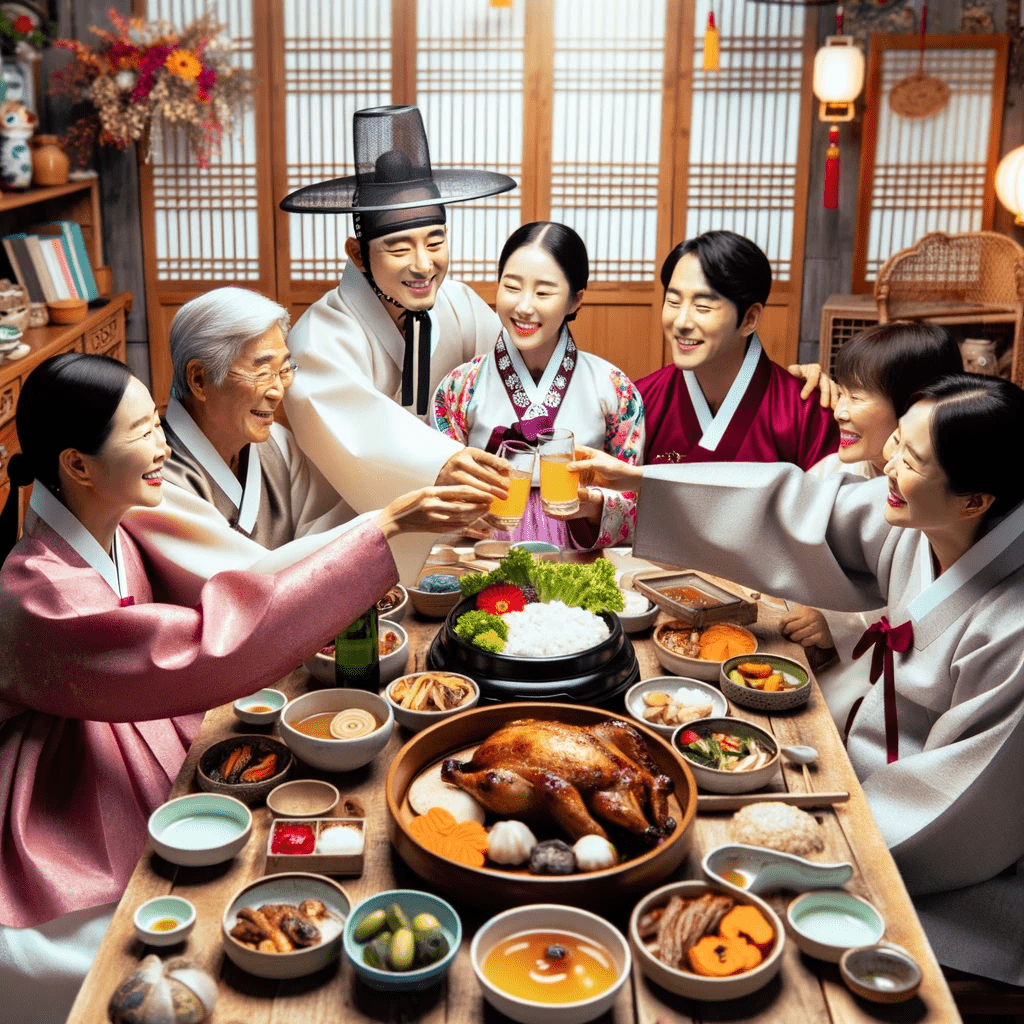Are you ready to embark on a journey into the fascinating world of Korean etiquette? Get ready to unlock the secrets of this rich culture and make a lasting impression.
In this article, we’ll guide you through the dos and don’ts of Korean etiquette, from dining customs to conversation etiquette.
Discover how every action reflects back on your family, company, and country, and learn the importance of respecting family values and higher status individuals.
So, let’s dive in and explore the beauty of Korean etiquette together!
Key Takeaways
- Korean culture is influenced by traditional and Confucian values, with an emphasis on family values, respect, and obedience towards higher status individuals.
- Seniors have more responsibilities and obligations towards their juniors, and status and dignity are highly valued in Korean society.
- It is important to adhere to general etiquette, such as taking off shoes when entering a residence, greeting people with a bow and a soft handshake, and giving and receiving objects using both hands.
- When dining, it is customary to start eating when the eldest person at the table begins, avoid touching food with fingers, and use a spoon to eat rice. Additionally, chopsticks and spoons should be placed back in their original position at the end of the meal.
Importance of Korean Etiquette
Understanding and practicing Korean etiquette is crucial for fostering positive interactions and showing respect in Korean society. The influence of Confucianism on Korean etiquette is significant, as Confucian values emphasize respect for authority, hierarchy, and the importance of maintaining harmonious relationships. These values are deeply ingrained in Korean culture and have a profound impact on social interactions, including business interactions.
In Korean business settings, proper etiquette is essential for building trust and establishing successful partnerships. Observing proper etiquette demonstrates professionalism, respect, and a willingness to adhere to societal norms. This includes bowing when greeting others, using formal language, and showing deference to elders and superiors.
Influence of Traditional Values on Korean Etiquette
The influence of traditional values on Korean etiquette is significant.
Traditional values, such as respect and obedience towards higher status individuals, shape the way Koreans interact and behave in social settings.
These values emphasize the importance of showing respect to elders, seniors, and those in positions of authority.
This emphasis on respect is reflected in various etiquettes, greetings, and manners observed in Korean culture.
Traditional Values Shaping Etiquette
To truly grasp Korean etiquette, it’s essential to recognize how traditional values have shaped and continue to influence it. Traditional values play a significant role in shaping the etiquette followed in various aspects of Korean society, including traditional Korean ceremonies.
Here are four key ways in which traditional values have influenced Korean etiquette:
-
Respect for elders: Korean culture places a strong emphasis on respecting and honoring elders. This value is reflected in the etiquette of bowing and showing deference to seniors.
-
Sense of hierarchy: Traditional Korean values emphasize the importance of hierarchy and social status. This is reflected in the etiquette of using formal language and gestures when interacting with individuals of higher status.
-
Group harmony: Korean culture values the concept of group harmony and maintaining a sense of collectivism. This is reflected in the etiquette of considering the needs and opinions of the group before making individual decisions.
-
Confucian principles: Confucianism has had a profound influence on Korean culture, and its principles are reflected in Korean etiquette. These principles include showing respect for authority, maintaining proper manners, and adhering to societal norms.
Importance of Respect
Respecting others is a fundamental aspect of Korean etiquette, deeply influenced by traditional values. The influence of respect holds great cultural significance in Korean society.
Traditional values, such as Confucianism, emphasize the importance of hierarchy and obedience towards higher status individuals. In Korean culture, seniors have more responsibilities and obligations towards their juniors, and status and dignity are highly valued.
Every action of an individual reflects back on their family, company, and country. This cultural significance of respect can be seen in various aspects of Korean etiquette, such as bowing when greeting others, using both hands when giving and receiving objects, and following dining and conversation etiquette.
Etiquette in K-pop Music Videos
Etiquette in K-pop Music Videos emphasizes cultural norms and behaviors. Cultural influences play a significant role in shaping the etiquette observed in K-pop music videos. Here are some key aspects of etiquette in these videos:
-
Appearance: K-pop artists are expected to maintain a polished and stylish appearance. Attention to detail in terms of makeup, hair, and wardrobe is essential.
-
Choreography: Precise and synchronized dance moves are crucial in K-pop music videos. Artists must follow the choreography with accuracy and precision.
-
Respectful gestures: Bowing and other respectful gestures towards fellow artists, crew members, and fans are common in K-pop videos. It reflects the importance of respect in Korean culture.
-
Expressiveness: K-pop artists are encouraged to convey emotions effectively through facial expressions and body language. This helps connect with the audience and enhance the overall impact of the music video.
Understanding and adhering to these cultural influences on K-pop etiquette is vital for artists to create videos that resonate with their audience and maintain the values of Korean culture.
Etiquette in K-pop Performances
When it comes to performing in K-pop, there are key cultural norms and behaviors that artists must adhere to.
Etiquette in K-pop concerts is crucial as it sets the tone for the entire performance. Artists are expected to be professional, energetic, and engage with the audience. They must also follow the choreography accurately and maintain a positive attitude throughout the show.
Additionally, etiquette in K-pop interviews is equally important. Artists are expected to be respectful towards the interviewers, answer questions thoughtfully, and maintain a friendly demeanor. They should also dress appropriately and be mindful of their body language.
Etiquette in Fan Interactions With K-Pop Artists
When interacting with K-Pop artists, it’s important to observe certain guidelines to show respect and appreciation.
Here are some etiquette tips to keep in mind during fan interactions and promotional events:
-
Be respectful: Always approach the artists with respect and maintain appropriate boundaries. Avoid invading their personal space or asking intrusive questions.
-
Follow instructions: Pay attention to the instructions given by staff members and follow them accordingly. This ensures a smooth and organized interaction for everyone involved.
-
Stay calm and composed: While it’s exciting to meet your favorite artists, it’s important to remain calm and composed. Avoid screaming, pushing, or causing chaos during fan interactions.
-
Show gratitude: Express your gratitude towards the artists for their hard work and talent. A simple thank you or a thoughtful gift can go a long way in showing your appreciation.
Korean Etiquette and K-pop Artists’ Behavior
During fan interactions and promotional events, it is important to observe certain guidelines to show respect and appreciation towards K-pop artists and their behavior. The influence of traditional values on modern society can be seen in the cultural exchange and adaptation within the K-pop industry. K-pop artists are expected to uphold Korean etiquette, which emphasizes respect for seniors and the importance of status and dignity. This is reflected in their behavior towards fans, where they often display humility, politeness, and gratitude. The table below highlights some key etiquette practices that K-pop artists adhere to:
| Etiquette Practice | Description |
|---|---|
| Bowing | K-pop artists often greet fans with a bow, showing respect and acknowledging their presence. |
| Handshakes | Artists may engage in handshakes with fans, using both hands as a sign of sincerity and warmth. |
| Fan Interactions | K-pop artists actively engage with fans, showing appreciation through eye contact, smiles, and personalized messages. |
These practices not only reflect the traditional values of Korean culture but also contribute to the positive image and strong fan base that K-pop artists have cultivated worldwide.
Impact of Korean Etiquette on K-pop Artists’ Image
The adherence to Korean etiquette by K-pop artists greatly influences their image and reputation. The influence of Confucian values, traditional values, and modern Korean culture on K-pop artists’ image is evident in their adherence to Korean etiquette. The impact of Korean etiquette on K-pop artists’ popularity and global appeal can’t be underestimated. Here are some ways in which Korean etiquette shapes the image of K-pop artists:
-
Respect and obedience: K-pop artists are expected to show respect and obedience towards their seniors and those in higher positions, reflecting the traditional values of Korean culture.
-
Dignity and status: Adhering to Korean etiquette allows K-pop artists to maintain a sense of dignity and status, which is highly valued in Korean society.
-
Representation of their country: Every action of K-pop artists reflects back on their country, so their adherence to Korean etiquette helps shape a positive image of Korea.
-
Global appeal: K-pop artists’ adherence to Korean etiquette enhances their global appeal by showing their respect for different cultures and traditions.
How K-pop Artists Uphold Korean Etiquette
K-pop artists demonstrate their commitment to Korean etiquette by actively embodying traditional values and customs. The influence of traditional values on their behavior is evident in their interactions with others and their overall image.
Korean culture places a strong emphasis on respect, hierarchy, and filial piety, and K-pop artists strive to uphold these values in their personal and professional lives. This adherence to Korean etiquette has a significant cultural impact, as it showcases the rich traditions of the country and serves as a positive representation of Korean culture on a global scale.
Examples of Korean Etiquette in K-pop Industry
As a fan of K-pop, you may have noticed how K-pop artists exemplify Korean etiquette through their actions and behavior. This isn’t surprising considering the rigorous training they undergo, which includes lessons on etiquette in K-pop training.
Cultural differences in K-pop etiquette are also taken into account, as artists are often trained to be respectful and polite to their seniors and colleagues. Here are some examples of Korean etiquette in the K-pop industry:
- Bowing: K-pop artists are known for their respectful bows when greeting or thanking others.
- Politeness: Artists are taught to use polite language and honorifics when speaking to those older or of higher status.
- Humility: K-pop artists often show humility and modesty, even when achieving great success.
- Teamwork: Collaboration and harmony within a group is highly valued, and artists are trained to prioritize the collective over individual desires.
These examples demonstrate how K-pop artists embody Korean etiquette, showcasing respect, humility, and teamwork in their interactions.
Benefits of Incorporating Korean Etiquette in K-pop
Incorporating Korean etiquette in the K-pop industry offers numerous advantages for artists and their interactions.
One major benefit is the promotion of cultural exchange. By incorporating Korean etiquette, K-pop artists have the opportunity to share and showcase Korean culture to a global audience. This not only increases cultural understanding but also fosters a sense of appreciation for Korean traditions and values.
Additionally, the cultural impact on the music industry can’t be overlooked. Korean etiquette emphasizes respect, humility, and discipline, which can greatly enhance the professionalism and image of K-pop artists.
Following Korean etiquette also helps artists establish strong relationships with their fans, as it shows their commitment to respecting and connecting with their audience.
Conclusion on the Significance of Korean Etiquette in K-pop
To fully appreciate the impact of Korean etiquette in the K-pop industry, it’s essential to recognize the significant role it plays in shaping the professionalism and cultural exchange within this global phenomenon. Korean etiquette goes beyond mere customs and traditions; it serves as a means of cultural representation and fan engagement.
The significance of Korean etiquette in K-pop can be understood through the following points:
-
Cultural representation: Korean etiquette reflects the values and traditions of Korean culture, allowing K-pop artists to showcase their identity and heritage to a global audience.
-
Professionalism: By adhering to Korean etiquette, K-pop artists demonstrate their commitment to professionalism, discipline, and respect, which are highly valued in the industry.
-
Fan engagement: Korean etiquette encourages artists to connect with their fans on a deeper level, fostering a sense of intimacy and appreciation.
-
Global appeal: Korean etiquette’s emphasis on respect and politeness resonates with fans worldwide, contributing to the international popularity and success of K-pop.
Frequently Asked Questions
What Are Some Common Etiquette Practices in Korean Daily Life?
In Korean daily life, it is important to practice proper etiquette. This includes observing Korean table manners and using traditional Korean greetings. These practices show respect and contribute to a positive impression.
How Does Korean Etiquette Differ From Western Etiquette?
Korean etiquette differs from Western etiquette in many ways. Cultural differences play a significant role, such as the importance of respect, hierarchy, and communal harmony. Understanding these differences is key to navigating social interactions in Korea.
Are There Any Specific Etiquette Rules to Follow When Dining in Korea?
When dining in Korea, it is important to follow Korean dining customs. This includes starting your meal when the eldest person begins eating, using a spoon for rice, and avoiding touching food with your fingers. Traditional Korean dishes are often served family-style.
How Do Koreans Typically Address and Greet Each Other?
Koreans typically address and greet each other with respect and honorifics. They use titles or kinship terms, such as "oppa" for older brother or "sunbae" for senior colleague. Greetings are important in Korean culture to show politeness and establish social hierarchy.
Are There Any Etiquette Guidelines for Non-Koreans Interacting With Koreans in a Business Setting?
In a business setting with Koreans, it’s important to have cultural understanding and be aware of potential language barriers. Being respectful, attentive, and mindful of Korean etiquette can help make a positive impression.
Conclusion
In conclusion, understanding and incorporating Korean etiquette is crucial for anyone planning to visit Korea or engage with its rich culture, including the K-pop industry.
By respecting traditional values, practicing proper etiquette, and adhering to social customs, individuals can make a positive impression and build meaningful relationships.
Whether it’s in dining, conversation, or interactions with K-pop artists, the significance of Korean etiquette can’t be overstated.
So, embrace the beauty of this culture and let Korean etiquette guide you through your journey in Korea.





0 Comments